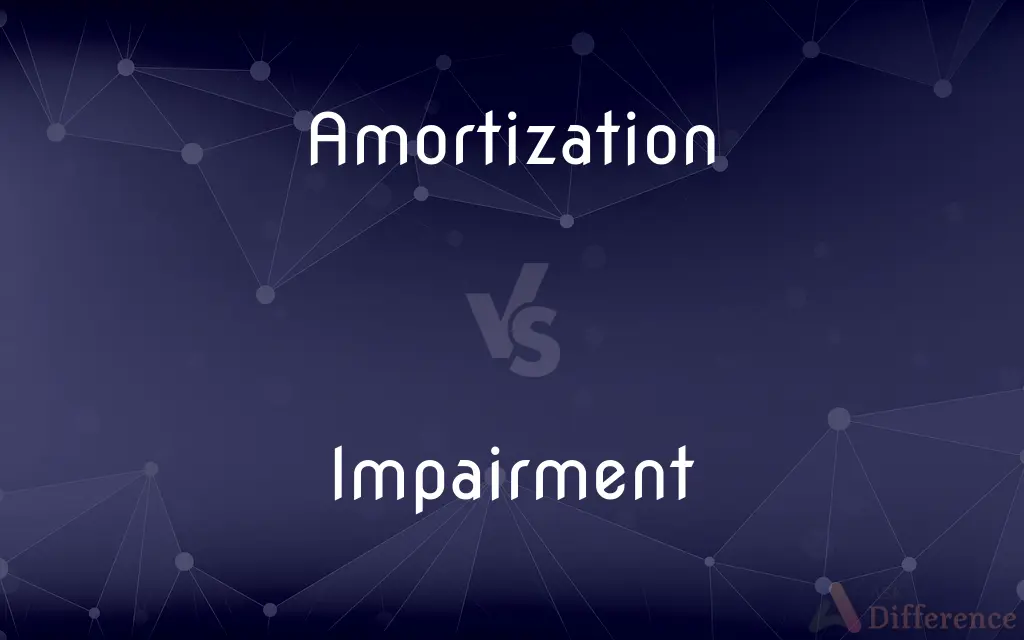Amortization vs. Impairment — What's the Difference?
By Urooj Arif & Maham Liaqat — Updated on April 18, 2024
Amortization systematically allocates the cost of an intangible asset over its useful life, whereas impairment reflects a sudden reduction in the asset’s recoverable value.

Difference Between Amortization and Impairment
Table of Contents
ADVERTISEMENT
Key Differences
Brief Comparison
Amortization systematically allocates the cost of an intangible asset over its useful life, whereas impairment reflects a sudden reduction in the asset’s recoverable value.
Detailed Comparison
Amortization involves the gradual expense of the cost of intangible assets like patents or copyrights over their estimated useful life. In contrast, impairment occurs when there is a sudden and unexpected decline in the recoverable value of an asset, whether tangible or intangible, making its recorded value on the balance sheet higher than its fair value.
Amortization is a planned, consistent accounting practice that is predictable and reflects the consumption of the economic benefits of an asset over time. On the other hand, impairment is reactive and often unpredictable, arising from changes in business circumstances or market conditions that negatively affect asset values.
ADVERTISEMENT
For amortization, the amount expensed is calculated based on the asset’s cost less any residual value, divided by the useful life of the asset. Whereas impairment testing involves comparing the carrying amount of the asset to its recoverable amount, which is the higher of the asset's fair value less costs to sell and its value in use.
Amortization is applicable exclusively to intangible assets. However, impairment can apply to both tangible assets like machinery and intangible assets such as goodwill or brand names, depending on the circumstances leading to a decline in the asset's value.
Amortization entries are made regularly throughout the asset's life, typically resulting in smaller, manageable amounts charged against earnings. In contrast, impairment can lead to large, one-time losses that significantly impact a company’s financial statements in the period in which they are recognized.
Comparison Chart
Applicability
Intangible assets only
Both tangible and intangible assets
Nature
Systematic and predictable
Sudden and unpredictable
Calculation
Based on useful life
Based on recoverable amount
Frequency
Periodic (e.g., annually)
Occurs when there is a significant reduction
Impact on Financials
Regular, smaller amounts
Potentially large, one-time charges
Compare with Definitions
Amortization
Allocation of loan payments.
Each mortgage payment includes amortization of principal.
Impairment
Reduction in asset’s book value.
The impairment of the factory was due to new environmental regulations.
Amortization
Process of spreading out a cost.
The amortization of the software development cost is over five years.
Impairment
Reflecting market value decreases.
The impairment test showed a decline in asset values.
Amortization
Systematic expense recognition.
Amortization helps in aligning expenses with revenues.
Impairment
Financial statement effects.
Impairment losses are immediately recognized in the income statement.
Amortization
Reduction in book value.
Amortization schedules are essential for financial forecasting.
Impairment
Loss recognition.
Impairment charges significantly impacted this year’s profits.
Amortization
Depreciation of intangible assets.
Patent amortization is crucial for intellectual property accounting.
Impairment
Non-recoverable asset value.
After impairment, the asset’s book value aligns more closely with its market price.
Amortization
Amortization (or amortisation; see spelling differences) is paying off an amount owed over time by making planned, incremental payments of principal and interest. To amortise a loan means "to kill it off".
Impairment
To cause to weaken, be damaged, or diminish, as in quality
An injury that impaired my hearing.
A severe storm impairing communications.
Amortization
The act or process of amortizing.
Impairment
The result of being impaired
Amortization
The money set aside for this purpose.
Impairment
A deterioration or weakening
Amortization
In reckoning the yield of a bond bought at a premium, the periodic subtraction from its current yield of a proportionate share of the premium between the purchase date and the maturity date.
Impairment
A disability or handicap
Visual impairment
Amortization
The reduction of loan principal over a series of payments.
Impairment
An inefficient part or factor.
Amortization
The distribution of the cost of an intangible asset, such as an intellectual property right, over the projected useful life of the asset.
Impairment
(accounting) A downward revaluation, a write-down.
Amortization
The act or right of alienating lands to a corporation, which was considered formerly as transferring them to dead hands, or in mortmain.
Impairment
The state, act, or process of being impaired; injury.
Amortization
The extinction of a debt, usually by means of a sinking fund; also, the money thus paid.
Impairment
The occurrence of a change for the worse
Amortization
The reduction of the value of an asset by prorating its cost over a period of years
Impairment
A symptom of reduced quality or strength
Amortization
Payment of an obligation in a series of installments or transfers
Impairment
The condition of being unable to perform as a consequence of physical or mental unfitness;
Reading disability
Hearing impairment
Impairment
Damage that results in a reduction of strength or quality
Impairment
The act of making something futile and useless (as by routine)
Common Curiosities
What is impairment?
Impairment is an accounting principle used to adjust the carrying amount of an asset when it exceeds its recoverable amount.
Can impairment affect both tangible and intangible assets?
Yes, impairment can affect both tangible assets like buildings and intangible assets like goodwill.
What triggers an impairment loss?
Impairment losses are triggered by a decline in the fair value of an asset below its current book value.
What is the purpose of amortization in accounting?
The purpose of amortization is to systematically reduce the carrying amount of an intangible asset over its useful life.
What is amortization?
Amortization is the systematic allocation of the cost of an intangible asset over its useful life.
What is recoverable amount in the context of impairment?
The recoverable amount is the higher of an asset's fair value less costs to sell and its value in use.
How often is amortization recorded?
Amortization is typically recorded on a regular basis, such as annually or monthly, depending on the asset and company policy.
How is amortization calculated?
Amortization is calculated by dividing the cost of an intangible asset by its expected useful life.
What is the main difference between amortization and depreciation?
Amortization applies to intangible assets, while depreciation applies to tangible assets.
What are examples of intangible assets that are amortized?
Examples include patents, copyrights, and software.
Is impairment reversible?
In some accounting frameworks, impairment of assets other than goodwill can be reversed if the value of the asset increases.
What are some common causes of asset impairment?
Common causes include adverse changes in legal factors, market conditions, and technology obsolescence.
How does amortization affect tax reporting?
Amortization can reduce taxable income by spreading the expense of an intangible asset over its useful life.
How does an impairment loss affect a company’s financial health?
An impairment loss can significantly reduce a company’s earnings and net assets in the period it is recognized.
Can impairment testing be deferred?
Impairment testing cannot be deferred and must be performed when there is an indication that the asset may be impaired.
Share Your Discovery

Previous Comparison
Longhorn vs. Oxen
Next Comparison
Chromosome vs. GeneAuthor Spotlight
Written by
Urooj ArifUrooj is a skilled content writer at Ask Difference, known for her exceptional ability to simplify complex topics into engaging and informative content. With a passion for research and a flair for clear, concise writing, she consistently delivers articles that resonate with our diverse audience.
Co-written by
Maham Liaqat















































